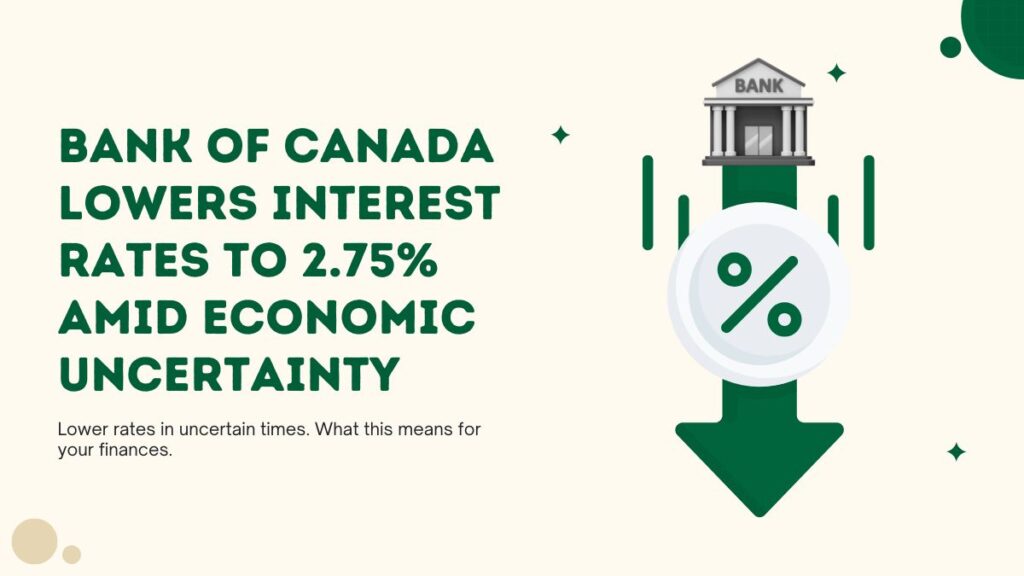AJP Mortgage is pleased to share the latest update from the Bank of Canada’s Financial Administration Division (FAD), released on March 12, 2025. Bank of Canada Lowers Interest Rates to 2.75% Amid Economic Uncertainty, cutting the overnight rate by 25 basis points to 2.75%. The Bank Rate is now 3%, and the deposit rate is 2.70%.
With trade tensions and new U.S. tariffs slowing the economy and raising costs, the Bank is lowering rates to make borrowing easier. This move is meant to support businesses, homeowners, and investors as they navigate uncertain times. By keeping the economy steady, the Bank aims to encourage growth and financial stability.
Bank of Canada Lowers Interest Rates to 2.75% Amid Economic Uncertainty
Big news for borrowers! The Bank of Canada just lowered interest rates to 2.75%. What does this mean for you?
Background & Context
The Bank of Canada’s latest rate cut didn’t happen by chance. What economic factors led to this decision? Here’s the key background you need to know.
Economic Climate
Canada’s economy is going through a tough time because of trade tensions and new U.S. tariffs. Growth is slowing, and prices are rising, making things more expensive for everyone. Borrowing money also costs more, so people and businesses are being more careful with spending. To help, the Bank of Canada is adjusting interest rates and taking steps to keep the economy steady.
Role of the Bank of Canada
The Bank of Canada helps keep the economy stable and inflation low. Its Financial Administration Division (FAD) shares regular updates so businesses, investors, and the public know what’s going on. These updates help people make smart financial decisions and stay confident about the future. Just like before, this latest update explains what the Bank is doing to handle the current challenges.
Key Announcements & Policy Decisions
The Bank of Canada’s latest rate cut is making waves. How will it impact borrowing, spending, and overall economic stability? Here’s what you need to know.
Main Decisions
On March 12, 2025, the Bank of Canada lowered its key interest rate to 2.75%, marking the seventh cut in nine months. This move is meant to support the economy as trade tensions and new U.S. tariffs put pressure on growth and inflation. The Bank wants to keep inflation stable and prevent rising prices from becoming a long-term problem.
Supporting Data
Economic Growth: Canada’s economy grew by 2.6% at the end of 2024, showing strength before recent trade issues.
Employment: Job growth was solid early in the year, bringing unemployment down to 6.6%. However, hiring slowed in February.
Inflation: Prices rose slightly in January and are expected to climb further in March as a temporary tax break ends.
These changes explain why the Bank is adjusting interest rates to keep the economy steady.
Analysis of Economic Indicators
The Bank of Canada’s rate cut will affect jobs, inflation, and businesses in different ways. Will it boost growth or create new challenges? Let’s break down the key economic signals.
Market and Economic Impacts
Lower interest rates make borrowing easier for businesses and consumers.
Inflation could rise due to trade tensions and new tariffs.
The economy was growing steadily in late 2024, but future stability is uncertain.
Risk Factors & Opportunities
Lower interest rates bring both challenges and opportunities. Here’s what to watch for.
Risks
Higher prices could make everyday goods more expensive.
Slower job growth may create financial uncertainty.
Businesses might face higher costs due to trade issues.
Opportunities
Cheaper loans could help businesses grow and invest.
Lower mortgage and loan rates may benefit consumers.
Investors could see stock market gains as borrowing gets easier.
Must Check: How Long Does Mortgage Approval Take After Pre Approval
Expert Commentary & Reactions
Economists and industry experts are weighing in on the rate cut—what does it mean for businesses, consumers, and the broader economy? Here’s their take on what comes next.
Official Statements
Governor Tiff Macklem stressed the need to prevent rising prices from becoming a long-term issue, aiming to keep inflation around 2%.
Policy Approach: The Bank of Canada acknowledges that while past rate cuts helped boost spending, ongoing trade uncertainty means future rate decisions will be made carefully.
Market & Analyst Reactions
Economic Experts say the rate cut is meant to soften the impact of U.S. tariffs, but the Bank is being cautious about further changes.
Market Response: The Canadian dollar and bond markets reacted to the rate cut, with investors watching inflation and economic demand closely.
Overall, the Bank’s decision reflects a strategic effort to support the economy while managing risks.
Future Outlook & Next Steps
With interest rates dropping and economic conditions shifting, what’s next for growth, inflation, and jobs? Here’s what to expect in the coming months.
What’s Next for Monetary Policy
The Bank of Canada will watch inflation and economic growth before deciding on more rate changes.
Future rate moves will depend on how trade tensions and inflation play out.
More updates or policy changes could come if the economy shifts.
Long-Term Impact
The rate cut is meant to keep the economy steady, but inflation and job growth will be key to watch.
Markets may stay uncertain as investors react to changing interest rates.
Canada’s trade relationship with the U.S. could shape future economic decisions.
Conclusion
With interest rates down and economic uncertainty ahead, what does this mean for businesses, investors, and consumers? Here’s the key takeaway.
Key Takeaways
The Bank of Canada lowered interest rates to 2.75% to support the economy as trade tensions and inflation rise.
Future rate changes will depend on how the economy, inflation, and global trade evolve.
In the months ahead, it’s important to watch inflation, job growth, and market trends.
What to Do Next?
Businesses, investors, and consumers should stay updated on the Bank of Canada’s announcements and be ready for any economic changes.
